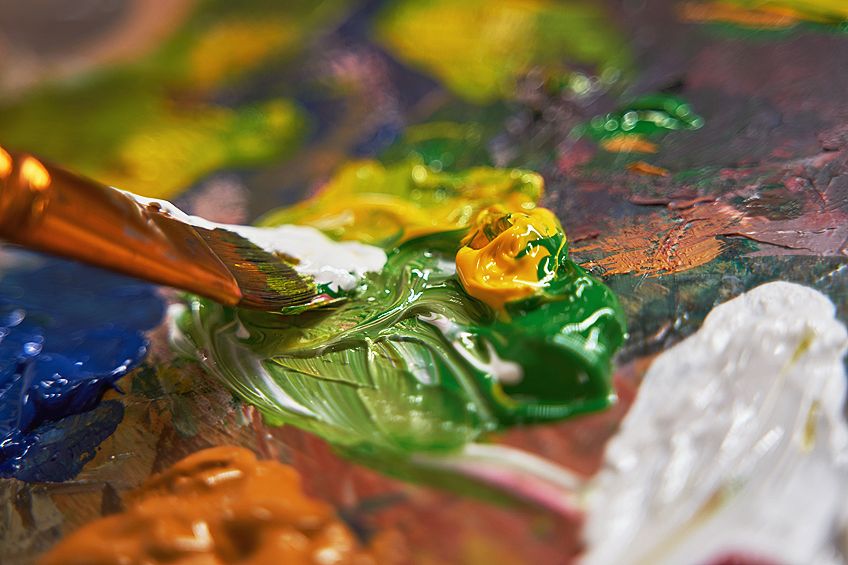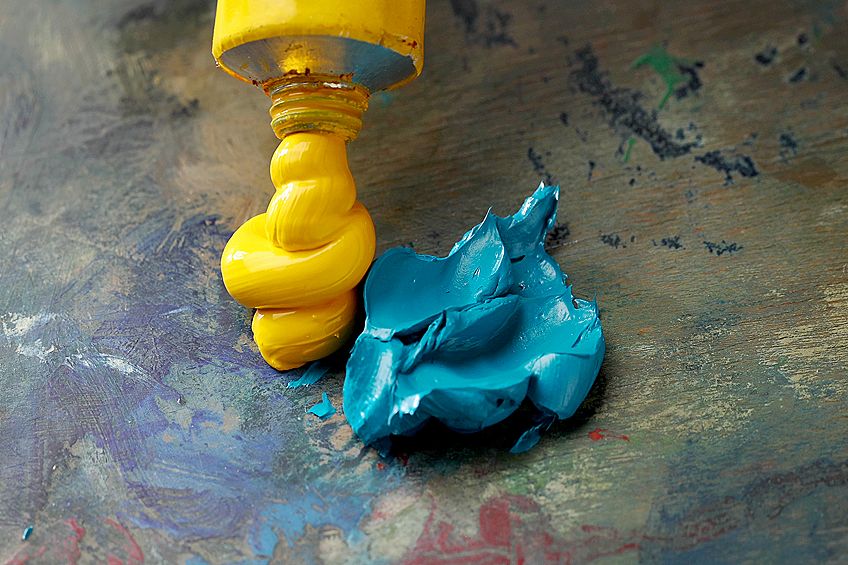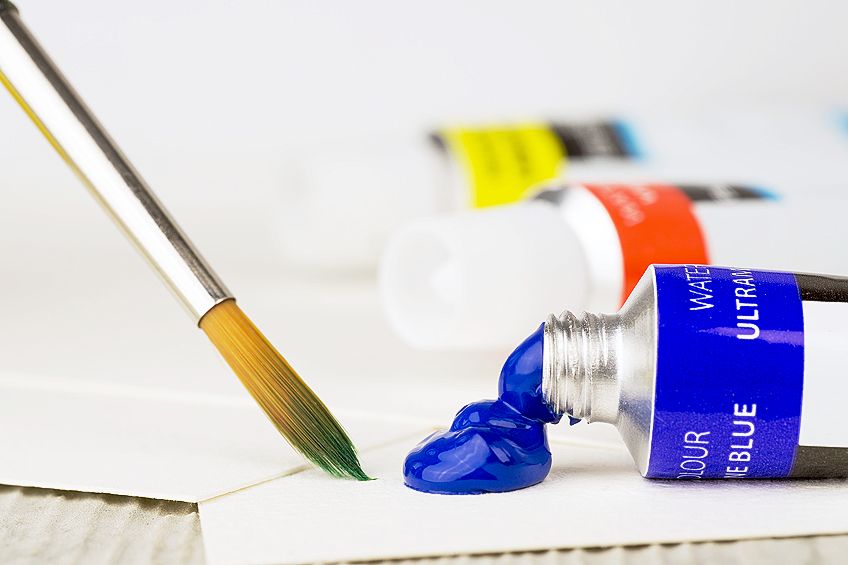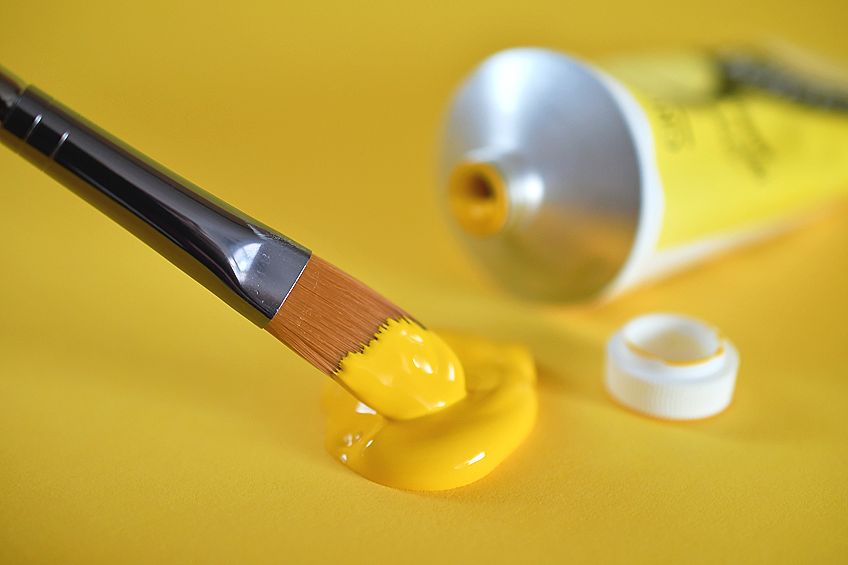Oil vs. Acrylic – The Difference Between Acrylic and Oil Paint
Which paint is better to use: oil or acrylic paint? This is a long-standing debate between painters from all levels of experience. The reality is that the answer isn’t as clear-cut as you would like. Various factors determine which paint is better to use in what scenario, in order to achieve the best finish. Before going into detail about the aspects that make certain paints better than others for a specific project, let’s get into what oil and acrylic paint are defined as.
What Is Acrylic Paint?
First, let’s discuss acrylic paint. What is acrylic paint, you ask? It is a widely popular paint that has a thick and creamy consistency, making it a firm favorite among painters from both the enthusiastic learner to a seasoned professional.
The paint is fast drying, helping you to paint at a quicker pace without the worry of smudging.
Three consistent aspects make up all acrylic paints: pigment, binder, and vehicle. The pigment is the factor that assists in giving the paint its vibrant hues and is present in the form of granular solids. The binder aspect is what assists the paint pigment in “sticking together” and staying in place as it dries. Acrylic polymer is key in this process.
Finally, the vehicle refers to what “carries” both these products, being the base formula. In this case, it is water.
The Pros and Cons of Acrylic Paint
Let us look a little further into the hotly debated topic of acrylic vs. oil paint. You may be contemplating: “what is acrylic paint used for?” The answer may lie in our list of pros and cons, but if it’s not that clear to you after, we do delve deeper into when the best time to use which paint is. More on that later, though.
Pros of Acrylic Paint
Various aspects make acrylic paint an impeccable choice for your next artwork. One aspect that is always appreciated by artists is the versatility of the products they use, and acrylic paints are no exception. If you’re wondering “is acrylic paint water-based?”, you’re spot on.
Thanks to the water-based nature of this paint, it can be watered down for a different finish that closely resembles that of oil paint.
Although the product can be watered down, it doesn’t impact the safety against water when dry. Your acrylic painting will still be fairly resistant against water even though it’s been diluted, as long as it’s stored and perceived correctly with suitable materials.
These products are also an incredible choice if you are concerned about any toxic ingredients in your paints. The wondering of whether or not acrylic paint is water-based and the positive confirmation means that there are no potentially harmful ingredients in acrylic paint, thanks to the water-based carrier.
It is still advised that you confirm this through the products listed under the ingredients before purchasing it, though. This paint is well-loved by both artists just starting and more experienced painters thanks to its versatility, rich finish, and relatively cost-effective nature.
Cons of Acrylic Paint
Now, onto the aspects that may prove tricky if you choose to use acrylic paints. Since the vehicle of acrylic paint is water, this means that this paint has a quick-drying nature to it. This may prove to be problematic if you are hoping to blend some of the paints for a different look.
Another aspect of this paint is that the shade may change once you have finished painting. The color you see while painting may not necessarily be the color that you are left with once the artwork is finished, as acrylic paint tends to darken once dry.
In conclusion, acrylic paints are ideal for any painters who wish for vibrant hues without a hefty price tag, and for those that do not want a long drying time.
What Is Oil Paint?
Are you wondering: “what is oil paint, then?”. Oil paint doesn’t differentiate far from the idea of acrylic, but there are key differences. First, the consistency is incredibly similar to that of acrylic paint, as it has a rich and thick consistency.
However, oil paint is considered to be a slow-drying paint and should be used with care.
The three aspects that make up the oil are almost the same as acrylic, with one vital difference. The components are pigment, binder, and solvent, as opposed to the vehicle. The pigment in this instance comes in the form of a powder that offers vibrant colors. The binder of this type of paint is linseed oil for the right consistency. Last but not least, the solvent which keeps it all together is mainly mineral spirits or turpentine but this may vary.
The difference between oil vs. acrylic paint may be small, yet they are immensely significant depending on what you wish for your experience and desired outcome and finish to be.
The Pros and Cons of Oil Paint
Now, onto the crowd favorite, oil paint. Oil paint has long been in the top picks of paints to use throughout the years, being the primary paint medium used by iconic artists including Salvador Dali, Leonardo da Vinci, Pablo Picasso, and Michelangelo. The greats can’t all be wrong!
Pros of Oil Paint
There are some significant reasons why artists from all walks of life are lovers of this paint medium. One of the major reasons why oil paints have been a constant favorite among painters is the rich, vibrant hue associated with them.
Oil paints are considerably more pigmented than other types of paints, leaving you with a truly striking work of art once done.
Besides their striking finish, these paints are considered to be immensely durable too. This long withstanding paint lasts for years to come if preserved correctly, and any harmful aspects that can occur including water damage, dust coating, or fading of paint can be restored without any damage to the artwork itself.
Since the binder of oil paint is usually linseed oil, the paint takes significantly longer to dry than other mediums.
Thanks to this, oil paints can be easily mixed without the worry of it drying too quickly, and you can correct any mistakes made on a painting before it completely dries. It is clear as to why oil paint is so sought after, thanks to its myriad of benefits that help you achieve a truly dreamy finish with all artworks.
Cons of Oil Paint
Even the most well-loved of paints have their pitfalls. Some potentially negative aspects of oil paints may make you think twice about using them. If you’re looking to save as much cash as possible, oil paints may not be the best choice.
Quality paints are an investment and oil paints are a prime example of that. They are considerably more expensive than acrylic paint, which can become costly if you want a variety of hues.
The slow drying nature of this paint has proven to be incredibly frustrating for some artists that have opted to use it. Oil paints usually take around eight hours to begin to set, and up to a full 24 hours before it is fully dry to the touch. The painting process becomes significantly more lengthy due to this aspect.
A myriad of painters feels that the benefits of oil painting significantly outweigh its downfalls, which is why it’s been such a highly sought-after paint throughout the ages.
In conclusion, the difference between acrylic and oil paint is minimal yet significant, and the reasons to choose which paint depends on a variety of factors that may be more about personal preference than user-friendly aspects.
When Should You Use Each Paint?
Since the debate of acrylic vs. oil paint is determined by the individual using the products rather than any specific product flaw, this question is completely up for interpretation. Below, we compare the two paints based on certain factors, which might help you to decide which paint to use.
What Is Currently Popular?
If you want to join the “cool kids” and follow which product is commonly the top pick in the world of art, you may want to turn to acrylic paint. Although a fairly new painting medium (it’s only been around for less than 100 years), it’s made a prominent name for itself in its short time.
The popularity is wide thanks to its diverse nature and easy-to-work-with consistency.
Not all painters want their paint to take a long time to try, which makes acrylic the ideal choice for those wanting a quicker finishing process. Acrylic is cost-effective, too, and who doesn’t want to save money where possible?
Which Paint Has Had the Longer Run of Popularity?
That being said, oil paints are still the first choice for many artists today, for a handful of reasons. First, it is the older paint, which makes sense as to why it is still highly sought-after since people tend to gravitate to what has a long withstanding good reputation.
As a recognized painting medium that’s been around since the 13th century within Europe and modernized to what we know it as in the 15th century, it’s a classic that world-renowned artists both past and present have trusted to help produce their most beloved paintings.
It boils down to the personal tastes of the painter, and what look you’re hoping to achieve with the finished product. Time availability plays a role too, but that aspect isn’t necessarily a deciding factor for most artists in the long run since painting is their passion, which they don’t mind putting extra hours into.
A Brief History of Oil and Acrylic Paint
Going back in time and learning more about how these universally well-loved paints came to be is intriguing in itself, and may help you better understand their uses. If you are wanting to understand the full differences between oil and acrylic paints, the origins of each are important to know.
The Origins of Oil Paint
We’ve already established that oil paint is centuries old, but it’s said to date back even further than records state within European use of the product. According to Britannica, the 11th century saw oil painting first being used, but was only utilized as an easel painting method later in the 15th century.
However, there is evidence to prove that the concept of oil painting has been recorded to be used from as early as the 7th century CE within the ancient city of Bamiyan in Afghanistan. Within the depths of the Bamiyan caves, locals adorned the walls within through the concoction of their version of oil paints. The “paint oil” is extracted from items including poppies and walnuts.
The 15th-century paints used linseed oil which is what is still used today, making it a long withstanding painting medium that has beaten the test of time. By the time the 16th century rolled around, Venice caught up on the oil painting craze; with Spanish painters not far behind thanks to Spanish artist Diego Velázquez leading the way within the 17th century.
Soon, other nations throughout Europe and eventually the remainder of the world caught up, and the rest, as they say, is history!
The Origins of Acrylic Paint
Are you still finding yourself asking the question “so, what is acrylic paint used for?”, after hearing the rave reviews of oil paints? Its history may help give you a glimpse into that since, for any product to be created, there must be a gap within the market.
This specific need would display itself during 1934 in Germany by an individual named Otto Röhm and fellow business partner Otto Haas (the duo behind the iconic chemical company Röhm and Haas). Röhm, a chemist, and Haas, an entrepreneur, joined forces to conceptualize, create and promote this form of paint.
The key ingredient was acrylic resin, which was first looked into through a thesis done by Röhm. The paints were initially used for the industrial industry, including decorating homes, as it was considered by painters to be too “runny” in nature.
However, the 1950s saw the paints becoming increasingly popular for commercial use thanks to their affordability, bright pigments, and ability to withstand any water exposure.
Some saw its fast-drying nature as a major plus too, making it a firm favorite for muralists. Specifically, Mexican muralists including David Alfaro Siqueiros, Diego Rivera, and Jose Clemente Orozco made use of acrylic paints. Other artists globally soon followed suit, including the likes of Sam Golden, Leonard Bocour, David Hockney, and Andy Warhol; among many others.
Today, painters from all works of life make this paint a regular medium that they trust in for all their artworks.
Techniques to Use for Oil and Acrylic Paints
How you paint your artwork should be considered just as important as the mediums and canvases you choose to use. In the case of oils and acrylics, some favorite techniques can help to create a memorable piece. Below, we will discuss some of the best techniques to use for each painting medium.
The Best Techniques for Acrylic Paints
You can create a painting rich in prominent patterns by simply pouring your paint onto the canvas directly. This is an ideal method for creating mind-bending abstract works. Simply mix whichever colors you wish within a utensil that helps you pour onto the canvas.
A palette knife is frequently used to create significant textures during painting. Simply apply the paint to the knife and watch as it creates striking textures within your work. Stippling is a popular method that can add some extra contrast to your work. Add bright spots of vibrant colors by dabbing the top of your brush onto your canvas repetitively for the desired effect.
A simple dry brush can be used for prominent strokes that add a unique touch of texture by adding some rough edges to the strokes. This method also really makes the pigment pop on your canvas.
The Best Techniques for Oil Paints
The tried and trusted palette knife is also popular within oil painting methods, just like with acrylic paints. Ragged edges of strong, pigmented colors that are created using a palette knife always look eye-catching, and are ideal for creating a truly striking work of art.
Looking for a way to add noticeable texture to your paintings? Scumbling is the best way to achieve this when it comes to oil paints. Move your brush in light, loose strokes over your painting to add contrast, with varied strokes for extra texture.
If you’re new to the world of oil painting, then underpainting is a useful method to help guide you. You essentially sketch your initial image as a rough draft of sorts, covering any blank parts of the canvas. Afterward, you use color to fill in the rest of your painting. These methods are designed to help painters with all levels of experience; from the enthusiastic beginners just starting in the world of painting, all the way to the seasoned artists.
No matter if you are a beginner or a professional artist, it is still important to know the difference between oil and acrylic paints. Whichever one you choose to utilize is completely up to you and the type of artwork you are wanting to create! However, this doesn’t mean that you shouldn’t try out both paints at some point. Experiment with both and see which one you prefer, as this is the quickest way to find out for yourself, as well as expand your painting skills.
Frequently Asked Questions
What Is Acrylic Paint Used For?
Do you find yourself wondering what acrylic paint is used for when trying to determine if it’s the best choice for your current project? There are instances when using acrylic over oil may be beneficial. For starters, if you want to create art on something different from a standard canvas, this paint’s versatile nature helps for just that. You can paint on items including fabric material, semantic pieces, chunks of wood, and even metal. This aspect is a big plus for anybody that is looking to create art that’s different from the regular canvas works that you see most of the time, which helps you to stand out from the crowd.
Are Acrylic Paints Water-Based?
While on the topic, you may have skimmed through the article and caught yourself wondering what the base ingredient of acrylic paint is. The answer is water, and this exact carrier is what helps you to create seemingly flawless works of art on whichever medium you choose.
Can I Paint Oil Over Acrylic Paintings?
Some people may wonder if there is a specific way you can make your acrylic paints have similar components to oil paintings, to maximize the benefits of both mediums. This is where painting oils over acrylics come in. If you would like your acrylic artwork to have the same durability, finish, and shelf life as an oil painting, you can simply coat it with a varnish or oil specially designed for the job.
How Can I Go About Painting Oil Over Acrylic?
If you want to go that route with your next acrylic artwork, certain methods work better. Painting oil over acrylic requires you to first make sure the product you’re using is suited to the task at hand. Before attempting to coat your painting, it needs to be completely dry, to avoid any mixing of the paint. It’s advised that you wait a couple of days before coating your work. Once the painting is fully dry, you can coat it with varnish, using brush strokes in the same direction. Once the first coat has dried, repeat the process going in the opposite direction as before. Two coats are sufficient in protecting and sealing your painting.
What Is the Biggest Difference Between Acrylic and Oil Paint?
Are you still puzzled as to what makes these paints such major competitors in the world of painting mediums? Arguably the biggest difference between acrylic and oil paint is the drying time due to their respective base products of water and oil. Besides that, there are no major deciding factors, such as quality or texture, that separate the two. It is about how quickly you want the painting and drying process to be, as well as how much money you’re looking to spend on paints.
Megan is a writer and researcher who holds a degree in Social Sciences, with a specialization in Psychology and Environmental Science, from the University of Cape Town. Her dedication to acquiring knowledge and making a positive impact has driven her current work in promoting conscious and sustainable growth in Southern Africa. Megan’s interests encompass exploring the physical and psychological impacts of color in our environment on our mood and well-being. She is also passionate about the role of art and creativity, which has been an integral part of society since the beginning of human history. Since 2022, Megan has been contributing blog posts on painting and color theory at artfilemagazine.
Learn more about Megan van Schoor and about us.
Cite this Article
Megan, van Schoor, “Oil vs. Acrylic – The Difference Between Acrylic and Oil Paint.” artfilemagazine – Your Online Art Source. February 8, 2022. URL: https://artfilemagazine.com/oil-vs-acrylic/
van Schoor, M. (2022, 8 February). Oil vs. Acrylic – The Difference Between Acrylic and Oil Paint. artfilemagazine – Your Online Art Source. https://artfilemagazine.com/oil-vs-acrylic/
van Schoor, Megan. “Oil vs. Acrylic – The Difference Between Acrylic and Oil Paint.” artfilemagazine – Your Online Art Source, February 8, 2022. https://artfilemagazine.com/oil-vs-acrylic/.


















